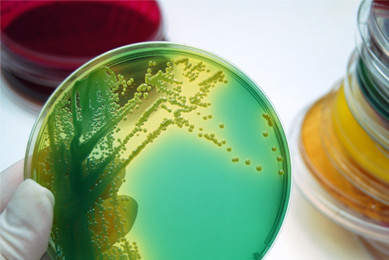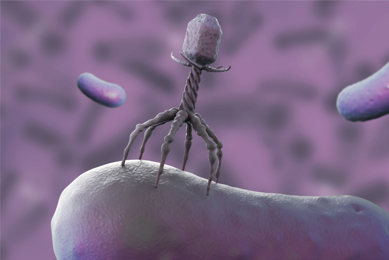The ATCC four-day phage propagation protocol
At ATCC, broth-based phage propagation is the standard due to its scalability and efficiency. This adaptable four-day protocol offers a reliable framework for diverse host-phage systems across research and industrial applications.
Day 1: Host cultivation
Start by growing the bacterial host under correct atmospheric conditions using suitable media. Host health is crucial—temperature, agitation, and nutrients must be optimized to ensure robust growth.
Day 2: Amplification
For optimal bacteriophage propagation, ensure your host cells are in the early log phase of growth. This stage provides actively dividing cells, which are most susceptible to bacteriophage infection and yield the highest viral output.
Day 3: Lysate prep and titration
After incubation, remove bacterial debris via vacuum filtration and perform a spot titer assay to estimate plaque-forming units (PFUs) for downstream use. Tip: Let titered plates dry before incubation to prevent spots from merging.
Day 4: Plaque check
Examine plates for individual plaques at higher dilutions. Calculate PFUs to confirm successful propagation and readiness for downstream applications.
Decoding bacteriophage problems: From prep to plaques to purification
To optimize plaque development, evaluate key factors affecting bacteriophage infectivity, replication, and purification. Once the filtrate is concentrated, a purification step may be necessary to remove contaminants that could interfere with plaque formation. Refer to the following factors to improve plaque development.
- Host growth phase: Bacteriophages need actively dividing cells. Use a spectrophotometer to confirm OD600 between 0.1–0.3 for early log phase. Starting with healthy, early log-phase cultures sets the foundation for consistent and efficient bacteriophage amplification.
- Multiplicity of infection (MOI) optimization: Optimize host-to-bacteriophage ratios. Extreme MOIs can disrupt infection—high ratios overwhelm the host; low ratios may not initiate replication. Use a microplate reader to optimize MOI conditions.
- Media composition: If plaques remain absent after determining appropriate MOI, supplement media with MgCl2 and CaCl2 (1–10 mM) to boost bacteriophage adsorption.
- Anaerobic host viability: To keep anaerobic bacteriophages healthy, the host bacteria must thrive in low-oxygen conditions. Use an anaerobic chamber or a sealed system and always work with pre-reduced media to maintain a stable, oxygen-free environment.
- Improving nucleic acid recovery: Polyethylene glycol (PEG) is often used as a preliminary step to concentrate bacteriophages by promoting aggregation and precipitation, enhancing lysate quality and yield before extraction.
ATCC: Supporting bacteriophage research excellence
ATCC provides reliable materials and expert guidance for bacteriophage research and development. When issues arise—like low yields or inconsistent plaques—revisit host health, media composition, and MOI. For deeper insights, watch the webinar ATCC’s Best Practices for Optimal Growth and Propagation of Bacteria and Bacteriophages, which covers techniques to improve plaque clarity and consistency.
Explore the ATCC Genome Portal
The ATCC Genome Portal provides customers with high-quality bacteriophage genomic data for research in microbial ecology, therapeutics, and synthetic biology. Access sequences and metadata to enhance reproducibility and innovation. Notable entries include:
- Escherichia coli phage Phi X174 (ATCC®13706-B1™): The first viral genome ever sequenced, a key reference for evolutionary studies.
- Pseudomonas fluorescens phage phi-S1 (ATCC®27663-B1™): Known for strong biofilm-lytic activity and potential in antimicrobial research.
Did you know?
The ATCC collection includes over 340 bacteriophages and their host strains.
Meet the author
Jeanette Rimbey, MS
Lead Biologist, Bacteriology, ATCC
Jeanette is a microbiologist with a decade of experience in bacteriology, molecular genomics, and veterinary medicine. Her scientific path began at the University of Missouri, where she studied bacteriophages under the mentorship of a Nobel laureate recognized for pioneering phage display technology. Since then, she has led research on antibiotic-resistant biofilms in Texas and contributed to Colorado’s COVID-19 diagnostic task force during the pandemic.
As Lead Biologist in bacteriology at ATCC, Jeanette drives process innovation in the bioproduction of BSL-1 and BSL-2 microorganisms, collaborating across teams to deliver high-quality biological materials that accelerate global research. My role blends scientific strategy with continuous improvement, supporting discovery across academic, industrial, and government sectors.
Explore our featured resources
ATCC’s Best Practices for Optimal Growth and Propagation of Bacteria and Bacteriophages
Discover the fundamentals of cultivating a wide variety of microorganisms and learn how to achieve ideal growth conditions.
More Culture guide
Culture guide
Bacteriology Culture Guide
Get expert tips on culturing bacteria including essential information about bacterial growth, propagation, preservation, and application.
More
Bacteriophages
Bacteriophages are viruses that target and infect specific bacteria. Since their discovery, these viruses have shown incredible promise as an alternative treatment for bacterial infections in humans. With the emergence of antimicrobial resistance among bacteria, understanding the therapeutic potential of bacteriophage therapy has become more important than ever. Explore our growing collection of bacteriophages and get your research started today.
More